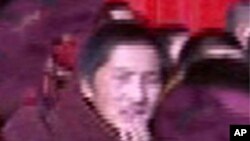A Tibetan monk self-immolated himself Monday in Ngaba County in eastern Tibet (Chinese: Aba County, Aba Autonomous Prefecture, Sichuan Province).
Tibetan exile sources with contacts in the area say 19-year-old Lobsang Gyatso of Kirti monastery shouted slogans against China when he set himself ablaze.
Reports say police and special security forces immediately extinguished the fire and took Gyatso away. His present condition and whereabouts are unknown.
Yesterday, an 18-year-old Tibetan nun died after setting herself on fire in an anti-China protest.
Tibetan exile groups claim that 23 people have burned themselves since March last year in desperate protests against China's growing repression of Tibetans.
Today's self-immolation is the 24th Tibetan self-immolation since Kirti monk Tapey set fire to himself on February 27, 2009.China has worsened crackdown in the Tibetan area of Ngaba, Sichuan, following the self immolation and death of a young Kirti monk called Phuntsog on March 16, 2011. Fourteen more Tibetans are known to have self-immolated from the Ngaba region since then.
In the aftermath of Phuntsog's protest and subsequent show of solidarity by the monks at Kirti monastery, the authorities launched a stringent patriotic education campaign at Kirti monastery, according to Kirti monks in exile.In April 2011, Chinese authorities seized more than 300 protesting monks from the Kirti monastery. Beijing at the time denied involvement in the disappearances, before later admitting the monks were undergoing enforced "legal education" at undisclosed locations.
Kirti monastery is one of the most important religioius institution in the area with more than 2,500 monks studying at the monastery.
The recent immolations that have taken place mark a dramatic escalation in the tactics opposing Beijing’s rule, and the Chinese government has been very critical of the actions.
The Chinese government has condemned the self-immolations, calling them a form of terrorism. Beijing has also accused Tibet's exiled spiritual leader, the Dalai Lama, of supporting such acts.
The Dalai Lama has denied encouraging self-immolations. In an interview with the BBC television last year, the 76-year-old Buddhist leader said those who set themselves on fire were brave, but that their sacrifice was not wise because it resulted in a tougher crackdown by the Chinese authorities.
The Dalai Lama fled into India in 1959 and has lived in exile for more than 50 years after fleeing a failed revolt against Chinese rule in Tibet.
Tibetans have long sought greater freedom from Beijing's rule, with some seeking complete independence and others wanting greater autonomy within China.











